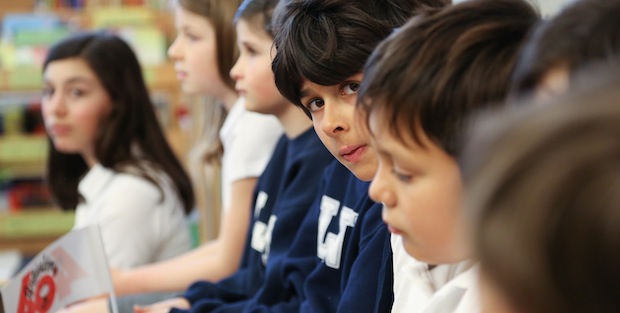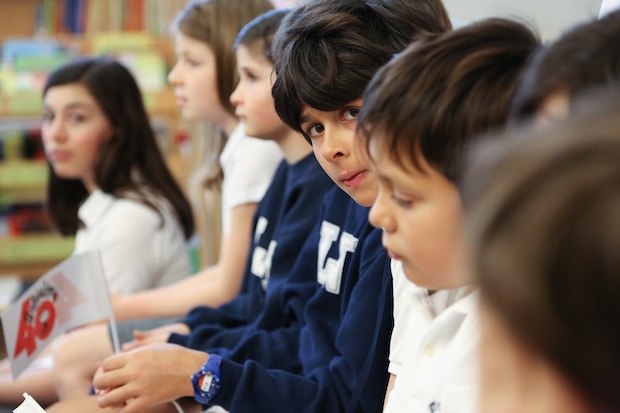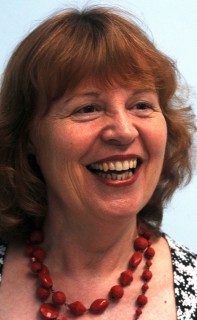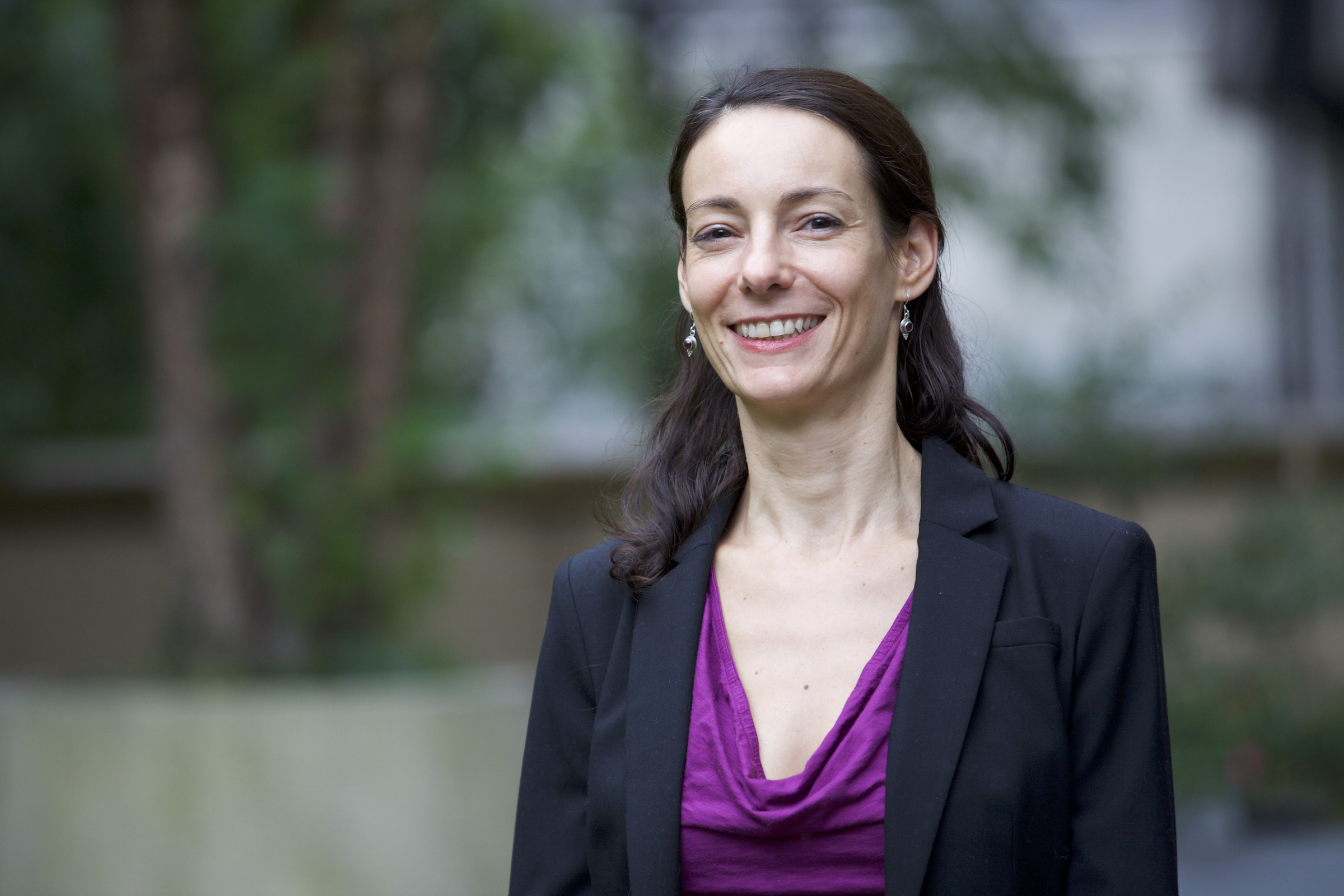Read an interview with renowned French scholar Christine Hélot, who has spent a lot of time studying the field of bilingualism. Dr. Hélot has led the creation of Je suis qui je suis, a special photo exhibit exploring the immigrant experience of students in France and the US. It will be shown in the LFNY Gallery during the Living with Two Languages Conference on Saturday, April 13 at the school. You can read more about the exhibit on FrenchCulture.org. The interview was conducted by LFNY teacher Nathalie Anton.
Since there are differing degrees of mastery of a second language, according to whether one learned it at birth, for example, or else later at school, what is the level one must reach before declaring oneself “bilingual”?
Your question contains three distinct points: 1) how to define bilingualism, 2) how to measure bilingualism, and 3) the question of age and language acquisition. Bilingualism is defined in many different ways, and these definitions often fall short because they don’t reflect the reality of what it means to be bilingual or multilingual. “Perfect” bilingualism does not exist, any more than perfect monolingualism does. No one speaks a language perfectly, so one cannot define a bilingual person based on the criteria of perfection any more than by the criteria of equal competence in both languages. Depending on the environment in which a bilingual lives, his or her age, and numerous other criteria, the degree of competence in the two languages will evolve and sometimes change.
No one speaks a language perfectly, so one cannot define a bilingual person based on the criteria of perfection any more than by the criteria of equal competence in both languages.
That brings me to the second part of your question: how to measure the skill level of an individual who speaks many languages, to decide if he or she is bilingual. The problem here is that for quite a while the yardstick for competency of bilinguals was based on that of monolinguals, but they cannot be compared directly. Being bilingual is not the sum of two monolingual competencies. Rather bilingual competency is a complex, integrated capability permitting not just self-expression in two different codes, but also the knowledge of when to switch from one to the other. One mustn’t overlook the intercultural competence of bilinguals who know how to navigate within two different cultural worlds and who must quite often negotiate these differences for monolinguals.
Researchers have often debated about the best age to acquire a new language and who have shown that different paths lead to bilingualism. In reality, many people in the world are bi- or multilingual but did not acquire their second language at birth or very early on in the family. And others grow up with many languages from the cradle but lose one of them in the process of their education, for example, because this language is stigmatized. One can thus become bilingual in the family, at school, or when living and working in another country. The person who functions satisfactorily in two languages in his daily life can thus be considered bilingual.
The person who functions satisfactorily in two languages in his daily life can thus be considered bilingual.
The problem with definitions that are too strict is that they exclude a good number of bilingual people who underestimate their skill level, who don’t dare to recognize themselves as bilingual individuals and who sometimes feel insecure with respect to their linguistic ability when looked down on by monolinguals who hold monolingualism to be the norm, or who see in bilingualism something exceptional. Let’s not forget that there exist in the world many more bi- and multilinguals than monolinguals, and that monolingualism is the exception, and it’s an exception that is easily cured!
What conditions are favorable for children and/or teenagers educated in a new country to become bilingual?
Children educated in a language other than that of their family are already bilingual. It is very important to name them as such, because it is a fairer evaluation of their language competency. Researcher Ofelia Garcia (one of the panelists during the Living with Two Languages conference) uses the term, “emergent bilinguals,” or “beginning bilinguals,” which means that from the moment these children are in the situation of learning in two languages, they function in two linguistic systems, and they are thus bilingual.
Next, to better develop their skills in two languages, appropriate teaching strategies must be in place. Research on bilingual education has come up with interesting findings. Though there may be multiple models of bilingual education in different regions of the world, there is not any one ideal model of bilingual teaching. Each model corresponds to a specific educational reality and must be considered in its educational, social, and political context.
Second language learning is constructed on the acquisition of the first language, and using two languages in a bilingual class can be an effective teaching strategy.
We then have to consider the relationship between the two languages in which students are learning. For a long time, it was considered preferable to separate the two languages to make sure that the students did not mix up the two linguistic systems. But today, we know that second language learning is constructed on the acquisition of the first language, and that using two languages in a bilingual class can be an effective teaching strategy. One may for example ask students to think about a text in their first language even if this text is presented in their second language, or to listen to a math lesson in one language and do the problems in the other. Bilingual learners will develop skills in both languages and use the multilingual resources at their disposal to accomplish all sorts of cognitive tasks.
A bilingual education means that students learn in two languages in school and learn to negotiate between their two languages rather than keeping them strictly separate from each other. A child is constructing his or her bilingual identity while in the process of discovering the world through two linguistic systems, and two or more cultures.
Should parents worry that the study of a new language could be detrimental to the first, and can their child excel in two languages?
If both languages are present in the classroom, the first will not disappear in favor of the second. Often when the mother tongue is not present at school, the language of teaching has a tendency to dominate and, little by little, to take the place of the first language. This is the case of a great number of children in France of immigrant parents, for example, whose mother tongue is stigmatized: these children arrive at school bilingual, but will become monolingual in an educational system that gives value to foreign languages but not to the languages of migrant children. I have analyzed this paradox in my work on the unjust nature of bilingualism in the context of French schools.
Anglicisms in the French-language papers of LFNY students are not a sign of confusion but the trace of the contact of their two languages in their cognitive functioning.
Learning a second language should never come at the expense of the first language, which is part of the construction of the identity of the child. The extensive body of work on bilingual teaching in the US, Europe, and elsewhere has shown that a very high level of skill can be reached not only in two but also in three languages in individuals whose languages are respected and valued by the educational system. No child should be ashamed of the language of his family, and all the languages of the children should be given legitimacy by the educator.
LFNY teachers often notice anglicisms in the French-language papers of students whose mother tongue is French. What mechanism is at work here, what confusion does it reveal, and should parents worry?
Anglicisms in the French-language papers of LFNY students are not a sign of confusion but the trace of the contact of their two languages in their cognitive functioning. These crossovers are a normal and common phenomenon for every bilingual individual and, in contrast with what people generally assume, are governed by known linguistic rules. LFNY students live in an anglophone environment where the English language dominates their everyday life even if they speak French at home and are educated in French. When one has two language codes to draw on, it is completely normal for them to influence each other. That said, it is also legitimate for these teachers to expect students to use standard French.
A bilingual speaker knows, for example, that two different words might symbolize the same object, which means that they know very early on how to negotiate two different cultural systems, to change from one to the other and to understand the rules of each one.
What I would recommend to teachers is working with students on these language crossovers – to make them think about the reasons for crossing over – in other words, to do a linguistic study of the similarities and differences between English and French. This work of metalinguistic reflection could turn out to be meaningful for the students who would see their linguistic practices less stigmatized and who would possibly better understand the usefulness of producing a text in standard French to succeed on exams, for example. With that said, let’s keep in mind that there is a linguistic creativity, born of the contact of languages and cultures in the world, that one sees in the writings of multilingual contemporary authors and artists, and in urban spaces where languages play against each other out of bounds of the rules explained in our grammar textbooks.
Besides the ability to communicate with others, what are the advantages of bilingualism?
The advantages of bilingualism or of multilingualism reside for the most part in this capacity that bilinguals have to see the world through two linguistic systems and thus to have a better understanding of the world around us. Very early their two languages allow them a certain perspective in comparison to speakers of one language. A bilingual speaker knows, for example, that two different words might symbolize the same object, which means that they know very early on how to negotiate two different cultural systems, to change from one to the other and to understand the rules of each one.
To learn two languages at school or in college, to think or to write in two languages, or between two languages, is to give life to a creativity that pushes back the frontiers of the languages and cultures of this world and thus, of our imagination.
Researchers have shown that bilinguals have a better sense of the subtlety and sensitivity in communication than monolinguals do. They take in more cues about people they interact with because from infancy they have had to pinpoint language choices in dealings with monolinguals. One may safely assume bilinguals to be better foreign language learners because the fact of having two languages at their disposal allows them to be less inhibited about learning others. Moreover, the skills acquired in two languages act as a basis for later learning. Finally, psycholinguists have also shown certain cognitive advantages such as the effect of bilingualism on divergent thought: it appears that bilingual children find more solutions than monolinguals to a question like “what can one make with three bricks?”
Potentially more important than the question of the instrumental advantages of bilingualism may be the question of its affective advantages. Not to speak the language of one’s parents or grandparents can be a source of suffering for any individual whose family history includes multiple languages and multiple cultures. To learn a new language at school can open doors to freedom of thought and ideas that one might not experience in a single language system. To learn two languages at school or in college, to think or to write in two languages, or between two languages, is to give life to a creativity that pushes back the frontiers of the languages and cultures of this world and thus, of our imagination.
About Christine Hélot:
Christine Hélot has been professor of English in the Teacher Education Department of the University of Strasbourg (France) since 1991. From 1975 to 1990, she was a lecturer in Applied Linguistics at the National University of Ireland (Maynooth College) where she was the director of the Language Center.
She has a PhD from from Trinity College (Dublin, Ireland) for a thesis entitled “Child Bilingualism: a linguistic and sociolinguistic study,” supervised by Dr David Singleton.
In 2005, she obtained her Habilitation for her research on bilingualism in the home and school contexts which was published in French in 2007 by l’Harmattan (Paris) 2007, under the title “Du Bilinguisme en famille au Plurilinguisme à l’école”. Her most recent publications include: Linguistic Landscape, Multilingualism and Social Change (2012) with M. Barni, R. Jannsens, & C. Bagna, chez Peter Lang, Language Policy for the Multilingual Classroom: Pedagogy of the Possible (2011) with M. O’ Laoire chez Multilingual Matters, Empowering Teachers Across Cultures, Enfoques criticos (2011) with A. M. de Mejia chez Peter Lang.
About the Author :
Professeure agrégée de Lettres Modernes et titulaire d’un Master professionnel de Psychologie clinique, Nathalie Anton a été membre pendant trois ans d’une équipe en charge de prévenir la violence en milieu scolaire dans l’académie de Paris. Elle est aussi l’auteur de l’ouvrage L’Art d’enseigner, paru aux éditions Ixelles en août 2012. Quand elle n’est pas en classe, Nathalie aime courir à Central Park et sillonner la ville à vélo l’été et se réchauffer dans les salles de spectacles l’hiver.




